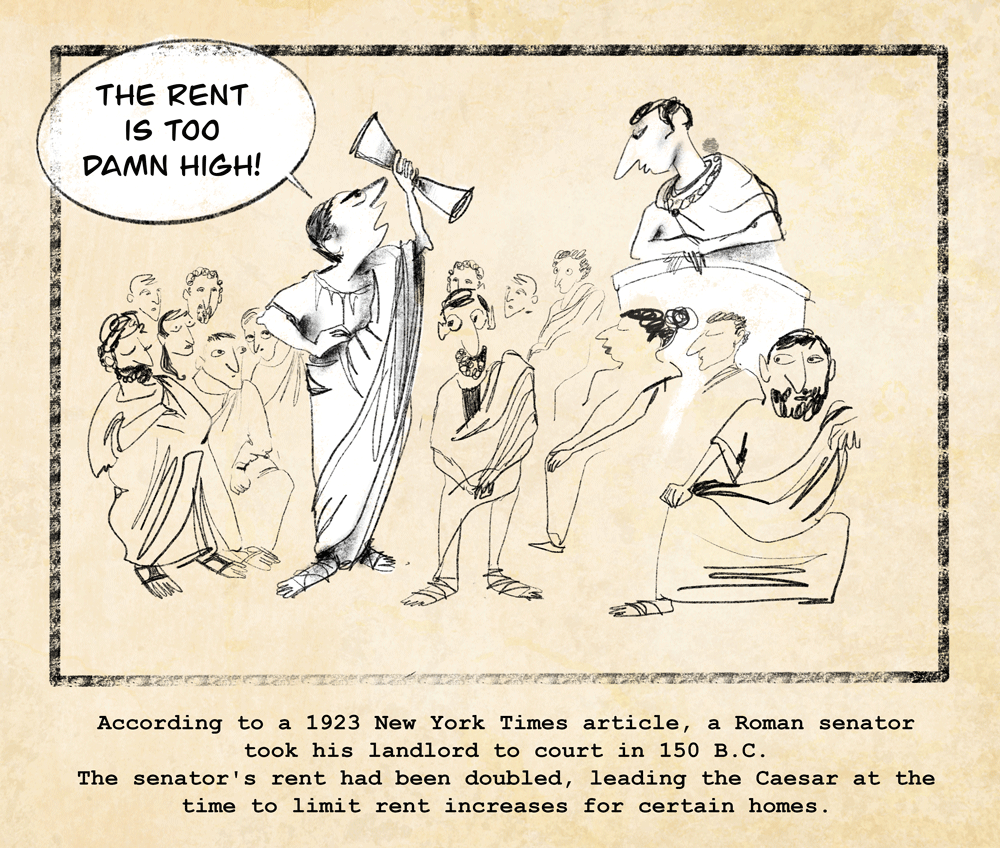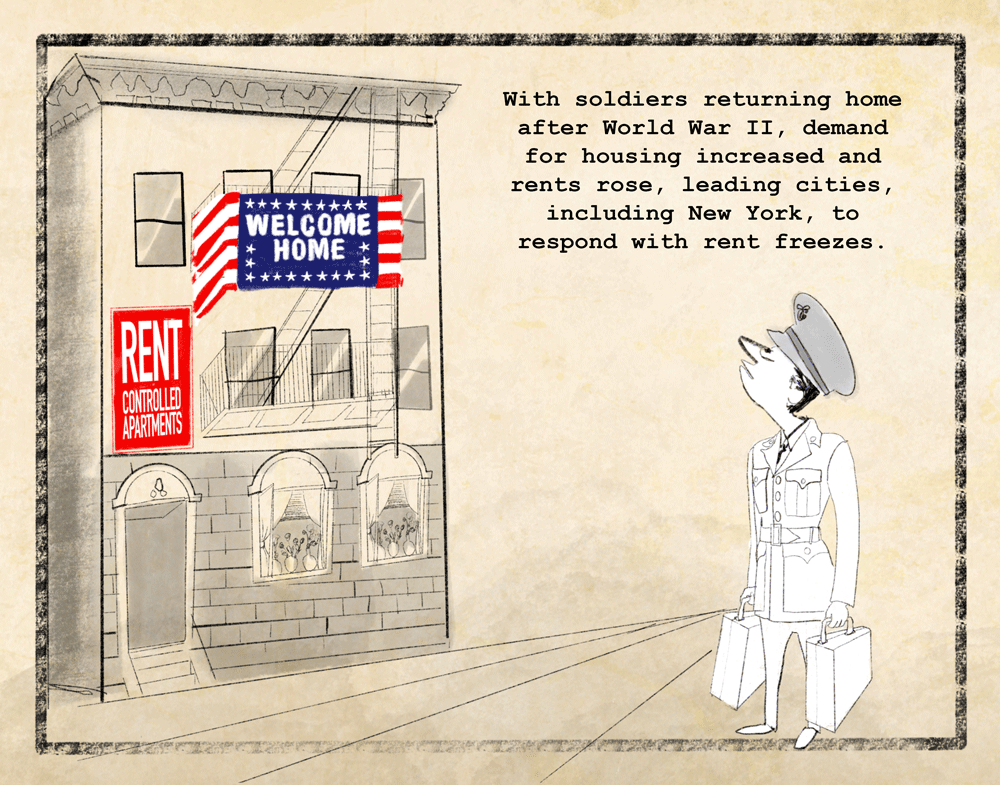Trending
 What’s going on with Ryan Serhant’s Central Park Tower penthouse listing?
What’s going on with Ryan Serhant’s Central Park Tower penthouse listing? Another woman alleges Oren Alexander raped her in New York
Another woman alleges Oren Alexander raped her in New York Spec mansion above Malibu’s Billionaire’s Beach goes for $32M
Spec mansion above Malibu’s Billionaire’s Beach goes for $32M Investors scoop up dev site near Pompano Beach casino for $29M, amid near record South Florida multifamily pipeline
Investors scoop up dev site near Pompano Beach casino for $29M, amid near record South Florida multifamily pipelineHow rent control battles are playing out across the US
A loose network of groups are winning key fights in some of the biggest cities and states.
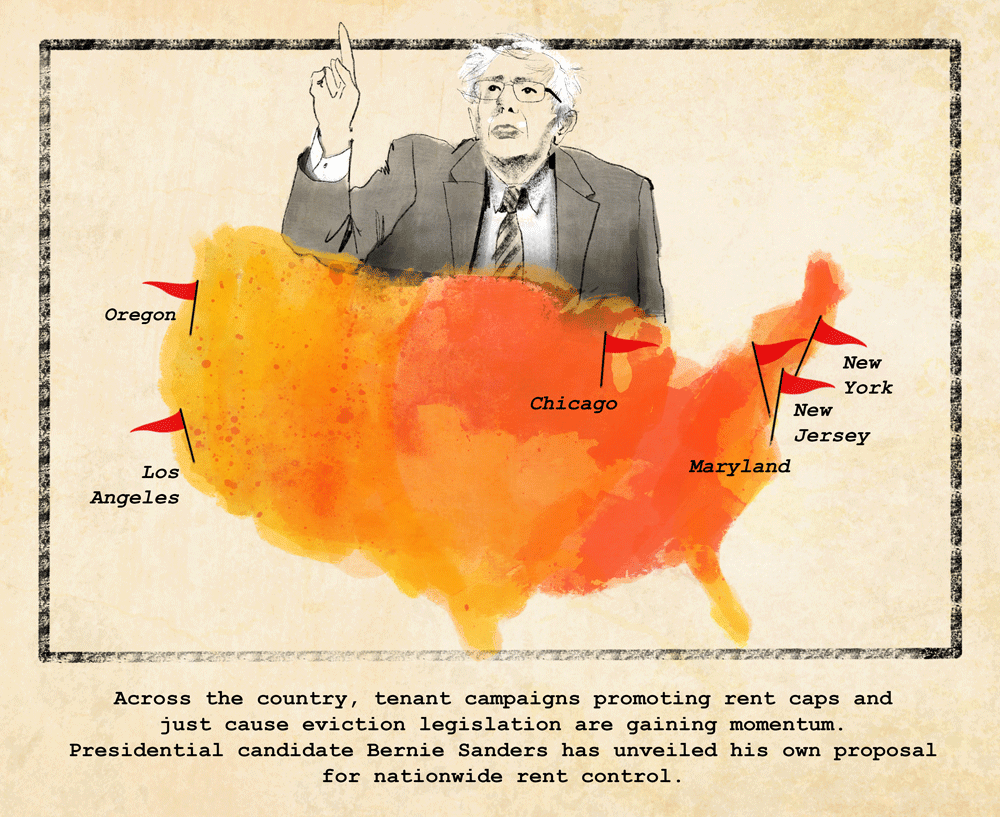
Days before Christmas in 2016, Karen Harvey was making plans for the holiday with her daughter when a piece of paper slid under her apartment door. It was an eviction notice.

Karen Harvey
Harvey and 200 other tenants in Philadelphia’s Penn Wynn apartment complex were told they would have to be out by March. “I was crushed. I felt like I’d been kicked in the face,” said Harvey. “The prospect of having to move in three months was overwhelming. Where was I going to get $2,400 to move?”
The owner, Cross Properties, didn’t realize that their business strategy would be a catalyst for the city’s tenant movement. While some renters found new apartments and others fought to stay, many joined the Philadelphia Tenant Union. A year later, Harvey spearheaded a successful campaign for the city’s first “good cause” eviction bill. Now, organizers and socialists show no signs of stopping, as they canvass neighborhoods in small teams to build support for rent control.
“From February to June we’re going to bang down City Council’s doors, just like we did with ‘good cause,’ until we get a rent control bill passed,” Harvey said.
There isn’t a single, organized rent control movement across the country. Instead, a loose network of groups like Harvey’s are winning key fights in some of America’s biggest cities and states. They’ve won “good cause” eviction requirements for New York mobile home communities and successfully fought for rent caps in Oregon and California. Groups across the U.S. and Canada are also sharing notes. One regular monthly conference call brings together 30 different tenant unions, including groups from British Columbia, Los Angeles, Iowa and Suffolk County. And they’re pushing for major reforms in Seattle, Colorado and Illinois.
Much of the reason the debate is generating such interest now is simply demographics: at least 5.4 million single family homes were converted into rentals in the decade after the foreclosure crisis. No longer just a stop on the way to homeownership for those near the poverty line, the share of renters has dramatically increased. Renters are now the majority in the 100 largest cities in the United States, according to a 2017 Harvard study.
Meanwhile, local landlord groups are lobbying city and state officials but haven’t yet tackled the issue as a united front. In some cases, including in California and Oregon, real estate owners have actually thrown support behind rent control, as a way to fend off more extreme reforms. Some states have enacted rent control sporadically or, in the case of 24 states, banned the practice entirely with preemptive bans. With at least one presidential candidate and a sitting congresswoman calling for nationwide rent control, tenant organizers are setting the agenda and the real estate industry is gearing up for more fights.
“Our country was based on something called the free economy,” said Dennis Block, a Los Angeles attorney whose eponymous firm evicts hundreds of tenants each month. “For some reason, when your name happens to be landlord, that concept is thrown out the window.”
Rent control, a brief history
Rent control has existed in some form in the United States since federal “fair rent” committees were created in 82 cities during World War I. Rent control gained popularity in cities after World War II in response to a housing shortage and rising rents. The housing boom of the late 1940s and 1950s saw many cities ditch such controls, though there was a resurgence of rent control in the 1970s when more than 200 communities sought to deal with a deluge of evictions. Since the 1980s, such policies have largely declined across the country.
Outside the U.S., rent control can be traced as far back as the Middle Ages. In 1562, Pope Pius IV in Rome eased housing restrictions and other forms of persecution against Jewish tenants, ordering their Christian landlords to stabilize rents, according to the Cornell Law Review. Though, there’s some speculation that the issue popped up in ancient Rome. An unsourced New York Times story in 1923 describes a Roman senator who took his landlord to court in 150 BC after he doubled his rent, causing Caesar at the time to cap rents of certain types of homes.
Urban Institute, a Washington, D.C.-based think tank, notes in a January 2019 report that there’s a gap in the research around rent control. Most crucially, analysis often doesn’t take into account the potential benefits of regulating rent increases, nor does it factor in how local regulations — like restricting condo conversions — can balance out the potential consequences of rent control.
“One of the big criticisms, which is why it’s in Economics 101 books, is that it throws off the natural supply and demand of the market,” said Mark Trekson, one of the authors of UI’s report. “What it does help is, it lets people stay in a unit longer than they would otherwise. It gets rid of those one-year shocks.”
Modern reports on the impact of rent control often laud the policy for creating greater stability for renters, who are able to stay in their apartments or neighborhoods for longer stretches of time. These reports, however, often temper such benefits with the looming concern that landlords will react by converting rental housing into condos or by simply neglecting their properties.
A widely cited 2018 Stanford University report, which studied the impact of San Francisco’s 1994 rent control law, found that owners reduced the supply of rental housing by 15 percent, largely through converting their properties. Another 2019 report by Columbia University found that rent control has a net positive impact and doesn’t lead to an overall decline in the quantity of rental housing, though it may mean apartments are built in areas outside urban centers. Stijn Van Nieuwerburgh, a professor of real estate and finance at Columbia and one of the report’s authors, noted that it’s crucial that affordable housing policies target lower-income residents and are paired with other regulations.
“Rent control does not create any new housing units, so it can never be a panacea to housing problems,” he said.
Roderick Hills, a professor of law at New York University, has advocated for making rent caps conditional on easing up zoning restrictions to encourage the construction of new housing.
“I am becoming more convinced that it is impossible to reduce regulatory obstacles to new housing without rent control,” Hills said. “Rent control might be an essential part of any package of policies designed to curb NIMBY zoning that is strangling our cities.”
Landlords shrug on the West Coast
On Feb. 4, Jim Straub, a third-generation landlord and director of the Oregon Rental Housing Association, appeared before the state Senate to offer his thoughts on a forthcoming rent control bill. The chamber likely expected the usual proclamations from landlords faced with new regulations: it will kill investment, conditions will deteriorate for tenants, and the housing crisis will only get worse. But that’s not what Straub told lawmakers.
“Let’s recognize it for what it isn’t: an industry killer,” he said. “There are drastic changes for landlords and investors in SB 608, but as written, I do not believe it will be catastrophic.”
When the sausage was finally made, Oregon had passed the nation’s first statewide rent control bill. But it didn’t look much like rent control, or what people traditionally think rent control looks like. While the legislature passed a “just cause” eviction provision, rent increases were capped at 7 percent, plus the consumer price index, which was 2.6 in August 2019, according to the Bureau of Labor Statistics. It was far higher than the two-to-three percent cap that had been rumored.
“It’s been a mixed bag. The bill may not be exactly what we wanted, but it was a significant step in the right direction,” said Katrina Holland, executive director of Community Alliance for Tenants, a group that pushed for the statewide measure.

Jim Lapides
Jim Lapides, vice president of the National Multifamily Housing Council, watched from afar when the bill passed. For his group, which lobbies across the country for real estate-friendly legislation, it was a path forward for similar legislation in the nation’s biggest state.
“California’s bill was definitely modeled after Oregon’s,” Lapides said.
Like 23 other states, California has legislation in place from the 1990s that prevents municipalities from enacting their own rent control measures. Tenant groups and activist Michael Weinstein made a habit of trying to overturn the rule. In 2018, Weinstein’s AIDS Healthcare Foundation spent $17 million to repeal the ban through a statewide referendum. But they were outgunned by the real estate industry, which spent $96 million and won in a landslide.
Whether it’s California, Oregon, Illinois or New York— rent control will be another impetus for investors: do I want to put my incremental dollar in a higher risk or a lower risk environment? — Jon Woloshin, a real estate analyst at UBS Global Wealth Management.
“The coalition had mapped out priorities in December, and a statewide rent cap was one of them,” said Arielle Sallai, chair of the Los Angeles Democratic Socialists of America Housing Homeless Committee. “When we saw rent control passing in other states like Oregon, it made it seem even more viable. We were hoping the national momentum would force our legislators to get a kick in the pants to finally do something.”
Months later, apparently responding to California’s housing affordability crisis, legislators proposed a rent control bill. Ahead of the vote, Essex Property Trust, a real estate investment trust that last year reported 83 percent of their income came from California, called the measure “balanced” on a quarterly earnings call.
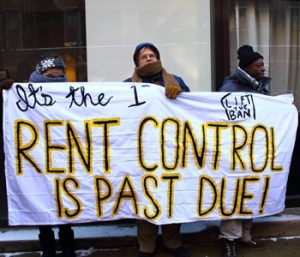
Protesters from the Lift The Ban coalition in Chicago
The legislature passed the bill: a 5 percent plus consumer price index limit on annual rent increases. The real estate industry was quick to warn that the measure would drive investors away from California.
“Whether it’s California, Oregon, Illinois or New York— rent control will be another impetus for investors: do I want to put my incremental dollar in a higher risk or a lower risk environment?” said Jon Woloshin, a real estate analyst at UBS Global Wealth Management.
Publicly, landlords decried the rent control measure for all the normal reasons. But privately, many were relieved: Essex Property Trust, for example, already had an internal policy of limiting increases to 10 percent. Anything higher would lead to “push back and phone calls almost immediately” from residents, Essex Property Trust CEO Michael Schall told his firm’s investors.
It seems like with AB 1482, he finally got it. And it goes to show — if [private equity giant and landlord] Blackstone is happy about it, it’s not as strong as we want it to be, but I guess it’s better than nothing. — Arielle Sallai, chair of the Los Angeles Democratic Socialists of America Housing Homeless Committee
While maintaining the appearance of rent control, the real estate lobby had successfully pushed for a few key provisions — it got a narrower definition of “good cause” eviction and exemptions for single family homes. More importantly, the rent control bill prevents municipalities from enacting their own stricter rent control measures. In other words, a bill the industry could live with that wasn’t very toothy, and wouldn’t get worse than that.
Sallai, of the DSA, wasn’t surprised that the rent control bill was watered down. Gov. Gavin Newsom has balked on rent control since 2014, she said.
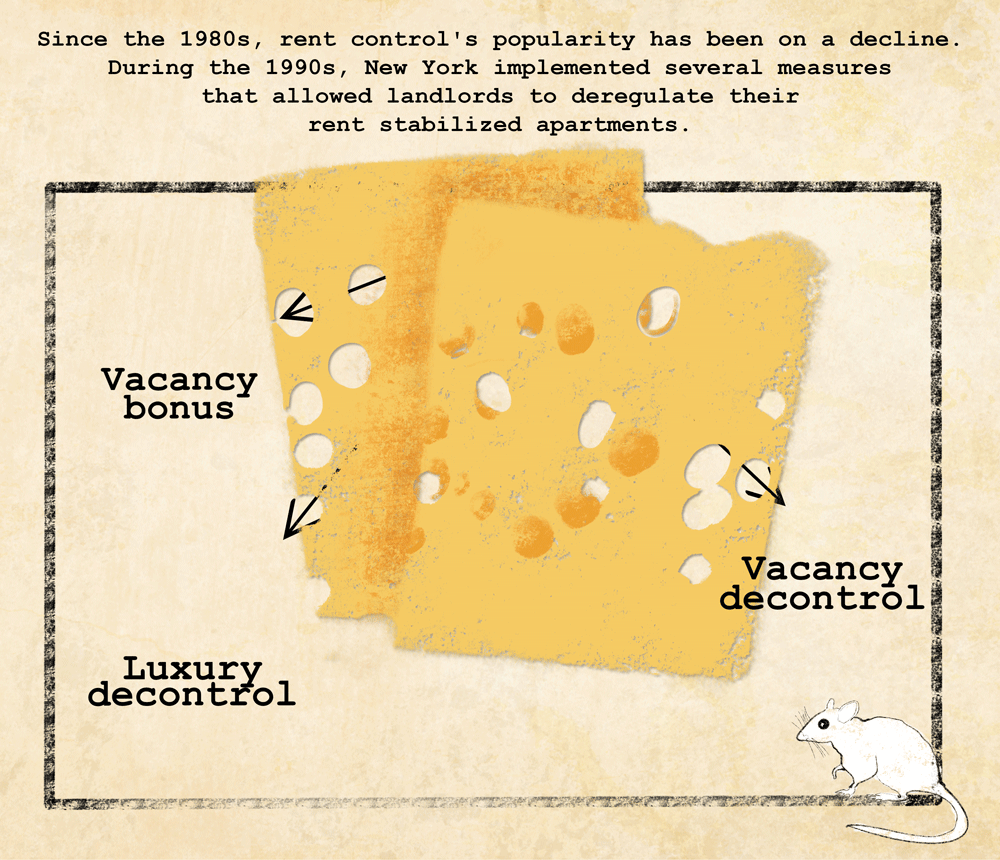
“We snuck in to a meet-and-greet to ask him about rent control — and he did his usual ‘walk away’ and said we needed a compromise,” she said. “It seems like with AB 1482, he finally got it. And it goes to show — if [private equity giant and landlord] Blackstone is happy about it, it’s not as strong as we want it to be, but I guess it’s better than nothing.”
Newsom is expected to sign the legislation as soon as October.
No rent control allowed
Chaining themselves together in the middle of Governor J.D. Pritzker’s office in Springfield, Illinois, 28-year-old Diego Morales and a half-dozen other activists from the “Lift the Ban” rent control coalition were hoping for a Hail Mary at the end of the legislative session.

Diego Morales (Credit: Facebook)
After six hours locked together with zip ties, the group did get a meeting— not with Pritzker, but with his staff. Their efforts were unsuccessful: the bill to repeal the statewide ban on rent control died in committee without ever making it to the floor for a vote. But the campaign led to some surprising political developments.
The organizations behind the effort, a coalition of left-leaning community groups, unions and the Democratic Socialists of America, used the unsuccessful campaign as a springboard, helping get six DSA-endorsed city council members elected. The candidates have all endorsed the “Lift the Ban” campaign and spurned campaign contributions from developers.
The result is a socialist bloc on Chicago’s 50-member City Council that is a constant thorn in the side of the real estate industry.
It’s good politics but lousy economics, — Brian Bernardoni, Chicago Association of Realtors senior director of government affairs
“DSA is not like other socialist organizations that are sometimes like reading clubs. We were out in the rain, in sub zero temperatures knocking on doors,” said Morales, a member of the DSA. “Now more than one tenth of the city council is socialist because we put boots on the ground.”
Brian Bernardoni, Chicago Association of Realtors senior director of government affairs, said he expects efforts to repeal the ban to be resurrected in the coming year, and the real estate industry should be wary of a rising movement that marries progressive groups with organized labor.
“It’s good politics but lousy economics,” Bernardoni said. “The progressive movement has taken root. We’ve been watching this for a while in Chicago and Cook County. Progressive candidates, organized labor and service employees unions are really addressing issues that are exciting voters.”
Rent caps in the Beltway
Meanwhile, some 80,000 rent controlled units in the nation’s capital stand to become market rate in December 2020 if the Washington, D.C. City Council doesn’t act.
The law, on the books since 1985, applies to apartments built before 1975, and permits landlords to hike rents each year by the consumer price index for urban wage, which was 1.0 in July 2019 for Washington D.C., plus 2 percent of the rent. Such increases are further capped for elderly and disabled tenants. Earlier this month, Council member Anita Bond proposed a bill that would extend rent control through 2030. It looks likely to pass.
“Despite nearly half a century of rent control, the District now has less than half as many low-cost apartments as there were 15 years ago,” a spokesperson for Bond said. “Without the District’s most important affordable housing program, rent control, the District’s population will become less diverse … Workforce housing will all but disappear.”
Tenants have also mobilized in the city. In July, residents launched a District-wide tenants union, with one of its goals being to fight for the renewal of the city’s rent control law. The city’s local DSA chapter also formed an anti-eviction campaign dubbed “Stomp Out Slumlords” in 2017. Stephanie Bastek, a member of the campaign and a board member of the tenant union, said elected officials haven’t done enough to ensure more units aren’t deregulated.
“[Bond] talked about expanding rent control and making it better when in fact she’s just maintaining the status quo,” she said.
Allison Hrabar, an organizer of the campaign, added that if the debate over reforming rent control heats up, she doesn’t expect it to be as controversial among local landlords as other housing issues in the city. The reason is simple — much of the district’s rental housing supply is made up of single-family homes, which are excluded from the city’s rent control law.
In the U.S., three states — Maryland, New York and New Jersey — have a form of rent control that only applies to certain apartments, according to the National Multifamily Housing Council. Only 1 percent of New York’s housing stock — about 22,000 apartments — are rent controlled, according to the last U.S. Census Bureau’s housing and vacancy survey. Rent control applies to tenants living in a building constructed before 1947, who have lived in the apartment since July 1, 1971 — or are a direct descendant of the original tenant. Far more apartments, roughly 1 million, are rent stabilized, meaning that annual rent increases in these units are decided by the city. The state legislature enacted other limitations on rents hikes in June with the passage of the Housing Security and Tenant Protection Act.
Local rule in Jersey
Across the Hudson River, it’s up to individual municipalities in New Jersey to decide whether to cap rent increases. According to the most recent survey of rent control throughout the state, conducted in 2009, more than 100 municipalities have rent control measures in place. Many are based on CPI, though some have provisions that set the limit based on whether tenants pay their own heating costs.
In April, Jersey City Council member James Solomon released a report that underscored the need to reform the city’s “broken” rent control system. According to the report, most tenants don’t realize that their apartment is regulated, leading to landlords to routinely disregard annual rent caps. In Jersey City, landlords who own multifamily buildings constructed before June 1983 with more than four units can only raise rent every 12 months by the lesser of 4 percent or the difference between CPI three months prior to the end of the lease and three months before the lease was signed.
Perhaps following New York’s lead, Jersey City is also considering amending how landlords are able to increase rents through renovations.
“We do want to strike a balance where there are still real incentives to keep apartments maintained,” Solomon said.

Ron Simoncini (Credit: SB One Bank)
Landlords in Jersey City are represented by Ron Simoncini, executive director of the Jersey City Property Owners Association and president of marketing firm Axiom Communications. Simoncini, who has helped landlords in more than 30 municipalities oppose rent control measures, said city officials should instead focus their energy on ensuring landlords properly register their units as rent controlled and enforcing other elements of the existing city ordinance before trying to put in place new regulations. He’s heartened by some of the discussions he’s had with council members and housing advocates, saying that many have realized that “rent control is not about affordable housing.” He said the issue of poor conditions at some properties shouldn’t be conflated with rent control.
“When people are hampered in their ability to generate returns, the capital leaks out of the business,” he said. “The notion that you punish the entire set of property owners because some set of property owners don’t care for their properties is the most dangerous notion in New Jersey, despite the fact that it’s absolutely ridiculous.”
The notion that you punish the entire set of property owners because some set of property owners don’t care for their properties is the most dangerous notion in New Jersey, despite the fact that it’s absolutely ridiculous. — Ron Simoncini, executive director of the Jersey City Property Owners Association and president of marketing firm Axiom Communications.
Columbia’s Van Nieuwerburgh said that while “one-size-fits-all doesn’t usually work very well,” instituting state or national-level policies could help get around local resistance.
“It’s the Nimbyism of the local homeowners,” he said. “The more local you go with the problem, the more likely you are going to run into opposition.”
Back in Philadelphia, the real estate industry is facing a growing threat, and one that is rousing national interest.
In September, presidential candidate Elizabeth Warren endorsed Kendra Brooks, who is running for city council in Philadelphia on the Working Families Party ticket. As part of her platform, Brooks is seeking to end a 10-year tax abatement granted to developers in the city — and enact rent control.
“Everywhere I’ve been in the last four or five years has a tenant movement,” said Philadelphia Tenant Union coalition coordinator Emily Black. “It’s the hottest issue on the left right now.”
Correction: An earlier version of this article misstated the net worth of Michael Weinstein.

